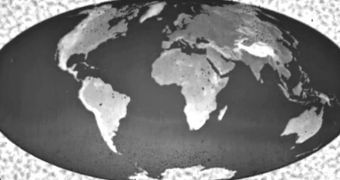Researchers at IBM announce the creation of one of the world's smallest 3D depictions of the Earth. The team managed to use a new technique for handling atoms to construct them into the intricate landscape that is our planet. The substrate from which the three-dimensional representation was derived was “painted and sculpted” using a very small tip tool, similar to the one generally employed in atomic force microscopes. The world map is the first-ever application of the new IBM technology, experts at the company say, quoted by TechNewsDaily.
The nanoscale globe features structures that are as little as 15 nanometers across, the scientists say. They add that, in order to be able to model at such a small scale, they first needed to develop a means of carving the original batch of material. The experts fixed the problem using a silicon-based tip, which is approximately 100,000 times smaller than the tip of the sharpest pencil. The silicon tip, encased in a special instrument, eventually allowed the researchers to obtain the impressive level of detail at which the map was produced.
“Advances in nanotechnology are intimately linked to the existence of high-quality methods and tools for producing nanoscale patterns and objects on surfaces. With its broad functionality and unique 3D patterning capability, this nanotip-based patterning methodology is a powerful tool for generating very small structures,” explains IBM Zurich physicist Armin Knoll. In addition to the global map, the team here also produced representations of the Alpine mountain Matterhorn (3D) and of the IBM logo (2D). Details of how the technique was applied appear in a recent issue of the esteemed scientific publication Advanced Materials.
In addition to its aesthetically-pleasing applications, the new silicon tip can actually be used in a variety of industrial processes as well. The IBM team says that the technology could be especially well employed in the field of nanoscale pattern imaging. Applied here, the silicon tip could make the process simpler and cheaper. If this happens, then the world could see more and more advanced electronics on the market. Increasingly often, such devices rely on nanoscale structures inserted into their circuits. Being able to produce these structures with higher efficiency would also promote innovation, the team concludes.

 14 DAY TRIAL //
14 DAY TRIAL //